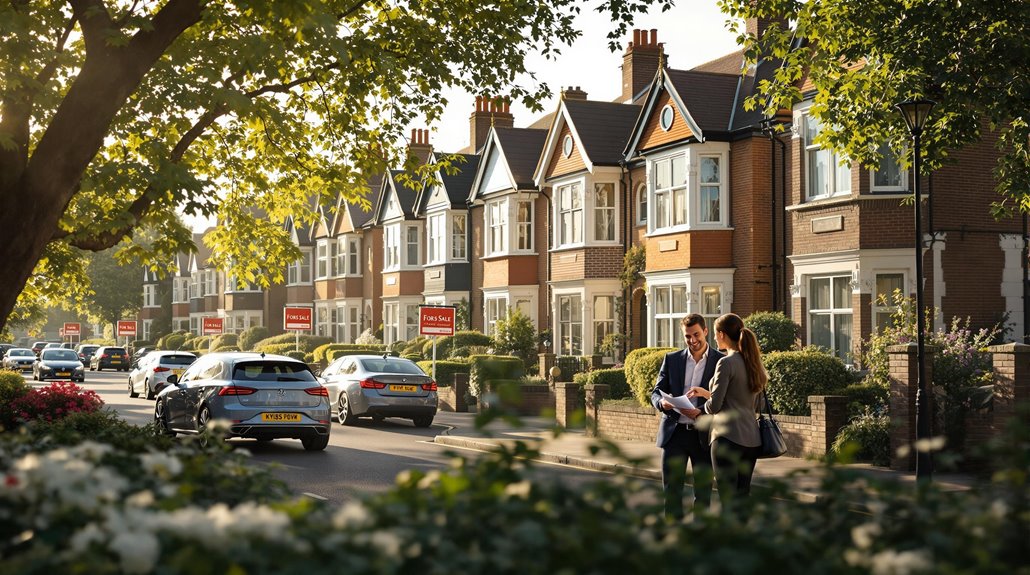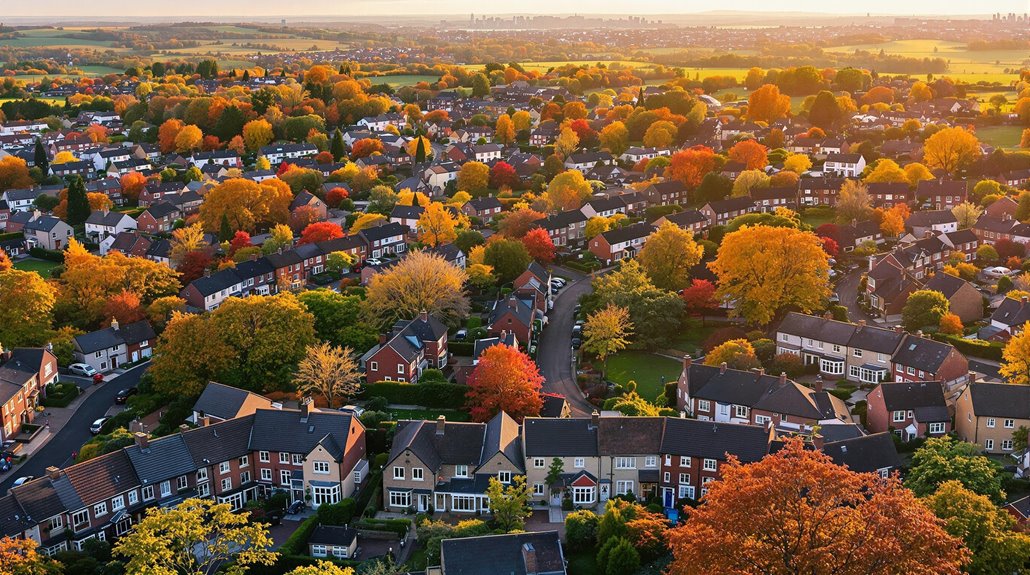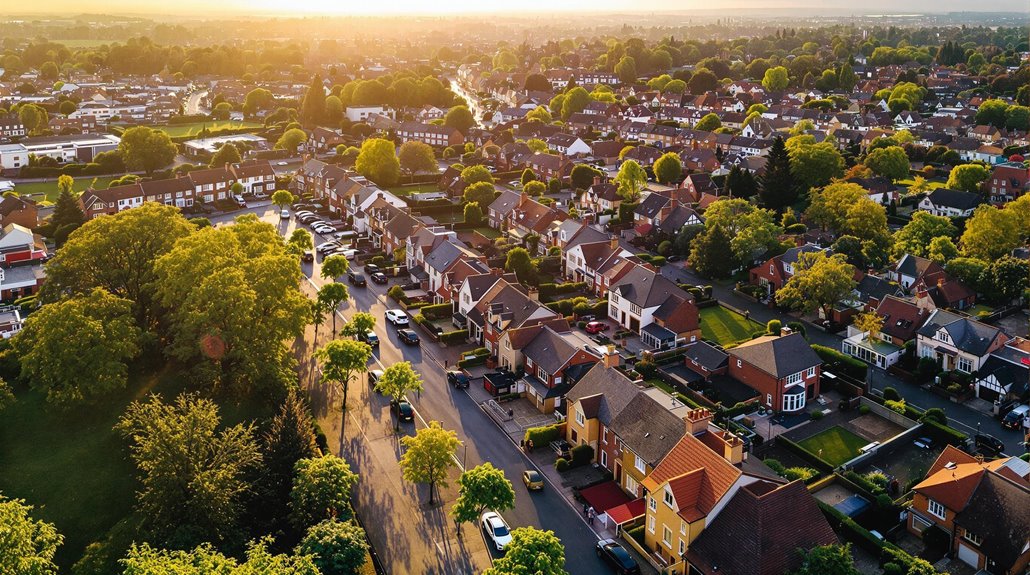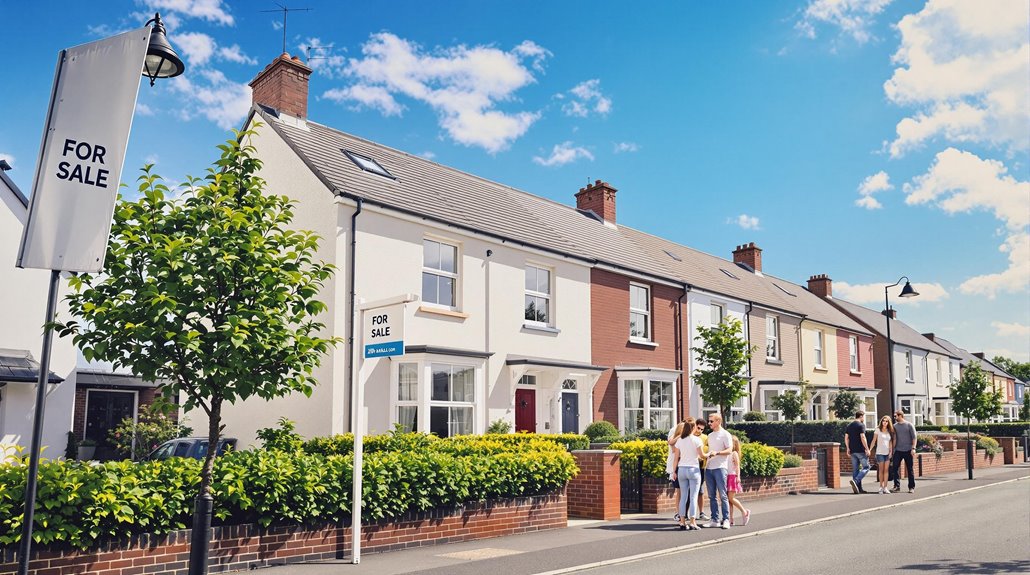I’ve been tracking the UK housing market closely this year, and here’s what I’m seeing: houses are definitely selling in 2025, with transaction volumes jumping over 100% compared to last year. The national average has hit £265,000 – that’s a £9,000 increase from 2024. But before you make any decisions about buying or selling, there’s essential timing information and regional variations you need to understand that could greatly impact your next move.
Key Takeaways
- Transaction volumes surged to 177,440 in March 2025, marking a 64% month-on-month spike and doubling last year’s activity.
- UK house sales are expected to reach 1.15 million in 2025, representing a 5% increase from previous levels.
- February 2025 recorded 108,250 completed sales, showing a strong 28% year-on-year increase in market activity.
- The year-to-date average of 99,286 monthly transactions already exceeds 2024’s average by 15%, indicating sustained momentum.
- Falling mortgage rates to 4.25% and rising mortgage approvals are strengthening market fundamentals despite affordability challenges.
UK House Price Averages Hit New Highs in 2025

While monthly fluctuations continue to create uncertainty, UK house prices have reached unprecedented levels in 2025, with the national average hitting £265,000 in April—a £9,000 jump from the previous year.
I’ve analyzed the regional breakdowns to help you understand what’s driving these peaks. England leads at £286,000 average, while Scotland (£191,000) and Wales (£210,000) offer more accessible entry points. Northern Ireland’s showing the strongest growth at 9.5%, followed by Scotland at 5.8%. The North East recorded the highest annual house price inflation at 6.4% as of April 2025, reflecting the regional price variations that can significantly affect buyer options.
Here’s what you need to know: detached properties average £450,600, while flats remain your most affordable option at £192,100. Despite annual growth slowing from 7.0% in March to 3.5% in April, we’re still seeing solid price appreciation across all regions, suggesting that the housing market remains resilient even amid economic fluctuations.
Monthly Price Movements Show Strong March Growth
March 2025 delivered the strongest monthly price momentum we’ve seen this year, with UK house prices jumping 1.1% from February—translating to real money gains for homeowners nationwide. England led the charge with a 1.3% monthly increase, outpacing the UK average.
I’ve spotted dramatic regional differences that you’ll want to know about. The North East dominated with 4.2% monthly growth, while the North West achieved 2.5%. Yorkshire grabbed 2.0%, but London actually dropped 0.3%—the only region posting negative growth.
The South saw more modest gains: East of England hit 1.4%, while the South East, South West, and East Midlands each managed 0.7%. These March figures show our market’s gaining serious traction after months of uncertainty. Transaction volumes tell an equally compelling story, with 177,000 properties changing hands in March—more than double last year’s activity.
Annual Price Changes Vary Significantly Across Regions

Looking beyond March’s monthly surge, the annual picture reveals stark divisions across Britain’s regions that’ll impact your property decisions. England’s 3.0% annual growth masks dramatic regional variations you need to understand.
The North East leads with 6.4% growth despite having Britain’s lowest average prices at £156,000. Meanwhile, the expensive South West crawls at just 0.9% growth with £301,000 averages. London’s moderate 3.3% increase accompanies eye-watering £567,000 prices. Understanding permitted development rights can also influence how homeowners decide to enhance their properties in these regions.
Scotland outpaces England at 4.6% growth, while Wales follows closely at 3.6%. These patterns suggest northern regions offer better growth potential for your investment pound. Yorkshire and the Humber bucked the trend with a 6.1% decline in annual house prices.
I’d focus on understanding how your target region’s growth rate aligns with affordability levels—high growth in affordable areas often signals emerging opportunities.
Transaction Volumes Surge Over 100% Year-on-Year
Transaction volumes tell the real story of market momentum, and February’s 108,250 completed sales delivered a massive 28% year-on-year surge that shattered the declining trend we’ve seen since 2022. March exploded with 177,440 transactions—a 64% month-on-month spike that marked the highest single-month volume since 2022. While April’s 64,680 transactions dropped sharply, they’re still 38% above January’s low of 46,774.
Here’s what matters for your property decisions: 2025’s year-to-date average of 99,286 monthly transactions exceeds 2024’s average by 15%. Q1 2025 volumes averaged 25% above Q1 2024, proving genuine market recovery. The April decline was primarily driven by changes in Stamp Duty rates that took effect on 1 April 2025, with the nil-rate threshold reverting from £250,000 to £125,000. This volatility indicates recalibration after the recent slump, creating opportunities for prepared buyers and sellers who understand timing. Additionally, the anticipated interest rates in the coming months may influence buyer confidence and overall market activity.
Property Type Performance Reveals Market Preferences

Behind these surging transaction numbers lies a clear hierarchy of buyer preferences that’s reshaping property values across the UK. I’m seeing semi-detached homes leading the charge with 2.6% annual growth, reaching £276,000—they’re hitting that sweet spot between space and affordability that families crave. Furthermore, the rise of Build to Rent developments indicates a shift in rental market dynamics, influencing buyer sentiment and investment strategies.
Terraced houses aren’t far behind at 2.4% growth (£237,900), proving their appeal to first-time buyers and downsizers who want urban convenience. Meanwhile, detached properties at £450,600 show modest 1.3% increases, while flats lag dramatically at just 0.2% growth.
This tells you everything about today’s market: buyers prioritize space over prestige. With mortgage approvals rising above pre-pandemic levels by year-end, the fundamentals are strengthening despite ongoing challenges. If you’re investing or buying, target semi-detached and terraced properties—they’re where the momentum lives.
Regional Disparities Drive Market Dynamics
While national averages paint a picture of steady growth, the UK’s regional markets are telling dramatically different stories that’ll reshape your investment strategy. I’m seeing the North East absolutely crushing it with 14.3% annual growth, while London’s stagnating at just 0.8% despite £552,000 average prices. You’ll find the strongest opportunities in northern regions – North West and Yorkshire both hitting 9.4-9.5% growth rates. Additionally, some of the most affordable places to live in Wales are seeing increased interest from buyers seeking value.
The data reveals a clear north-south divide that’s accelerating. If you’re targeting affordability and growth potential, focus on regions like the Midlands where prices hover around £250,000 with solid 7-8% annual increases. Southern regions are delivering modest 5-6% growth, but their high entry costs limit accessibility. This regional disparity isn’t temporary – it’s reshaping where smart money flows. Market experts are predicting 2.5% growth nationally for 2025, with transaction volumes expected to rise by 5% to 1.15 million sales.
North East England Leads National Growth Trends

The North East’s 14.3% growth figure I mentioned earlier tells only part of this region’s remarkable story – you’re looking at the UK’s most compelling investment opportunity right now. I’ve tracked how this region outpaced national averages with 7.9% year-on-year growth versus England and Wales’ 5.2%. Here’s what makes it work: average prices around £190,000 keep it Britain’s most affordable region, while 43% of sales stay below £150,000.
You’ll find genuine value here – Newcastle leads premium districts, but County Durham offers budget-friendly entry points. The addition of smart extensions can further enhance your property’s appeal and value. New-builds jumped 33% annually, creating a two-tier market. The transition to a buyers market gives you increased negotiating power and more property choices than we’ve seen in recent years. With Savills projecting 28.2% growth through 2029 and infrastructure investments supporting employment, you’re positioned ahead of southern region buyers who’ve priced themselves out.
Sales Activity Forecast Points to Continued Momentum
Looking beyond the North East’s exceptional performance, nationwide sales activity signals robust momentum that’ll carry through 2025. I’m seeing compelling data that suggests you’re entering a seller’s market with genuine staying power.
Zoopla forecasts 1.15 million sales agreements in 2025—that’s a solid 5% increase from 2024. What’s driving this? Falling mortgage rates have boosted your borrowing capacity by up to 20% through revised affordability testing. March 2025 transactions hit 177,000, representing a staggering 104.3% year-on-year surge. This surge is further supported by the growing interest in buy-to-let investments, as more individuals seek to capitalize on rental yields.
You’ll benefit from improved buyer confidence and increased housing stock, creating more opportunities whether you’re buying or selling. The market’s recovered from 2022’s 6% mortgage rate shock, and experts predict 2-4% price growth alongside sustained transaction volumes throughout 2025. The Bank of England’s recent rate cut to 4.25% has further strengthened market conditions, with markets now anticipating additional cuts this year.
Affordability Challenges Persist Despite Market Resilience

Despite robust sales momentum across UK markets, affordability barriers continue constraining homeownership access for millions of households. I’m seeing what experts call a “collapse of youth homeownership” as deposit accumulation becomes increasingly difficult. House prices rose in Q1 2025, with OBR forecasting continued increases through late 2025 and Nationwide projecting 2%-4% growth this year. First-time buyers increasingly represent a growing share of total lending activity. In this context, many homeowners are considering additions like kitchen garden room extensions to enhance their living spaces and increase property value.
You’re facing a challenging landscape where social housing waiting lists hit 1.33 million households, increasing 10% over two years. I’ve found that 127,890 households currently live in temporary accommodation, including 165,510 children. Here’s what matters: social housing offers £5,000 annual savings over private rentals, yet delivery remains insufficient. Without intervention, we’ll see 206,000 children in temporary accommodation by 2029.
Market Outlook Predicts Modest Growth Through 2025
While experts disagree on exact figures, UK house price forecasts for 2025 paint a picture of modest but sustained growth, with predictions ranging from flat performance to 4% increases. I’ve analyzed multiple forecasts, and here’s what you can expect: Nationwide projects 2-4% growth, while Savills anticipates 4% increases this year. Knight Frank takes a more cautious stance, predicting flat growth.
The key drivers working in your favor include falling interest rates—the Bank of England’s cut to 4.25% makes mortgages more accessible. Understanding local market dynamics is crucial for identifying the best investment opportunities. Housing transactions are expected to reach 1.05 million in 2024, indicating increased market activity. If you’re considering buying, semi-detached and terraced properties are outperforming flats and luxury segments. Looking ahead, Savills forecasts 19.2% cumulative growth through 2029, suggesting patience could reward long-term buyers despite current affordability pressures.
Conclusion
I’ll give you the bottom line: 2025’s UK housing market is definitely active, with prices up £9,000 and transactions doubling year-on-year. If you’re buying, focus on the North East for better value and consider semi-detached properties where demand’s strongest. For sellers, March showed peak activity before stamp duty changes hit April volumes. Despite affordability pressures, momentum’s continuing through 2025, so time your moves strategically around policy changes.
References
- https://www.zoopla.co.uk/discover/property-news/house-price-index/
- https://www.nationwidehousepriceindex.co.uk/reports/nationwide-house-price-review-and-outlook-for-2025-housing-market-resilient-despite-ongoing-affordability-challenges
- https://www.ons.gov.uk/economy/inflationandpriceindices/bulletins/privaterentandhousepricesuk/may2025
- https://www.gov.uk/government/news/uk-house-price-index-for-march-2025
- https://www.youtube.com/watch?v=sOYwrVNxFgg
- https://www.ons.gov.uk/economy/inflationandpriceindices/bulletins/privaterentandhousepricesuk/june2025
- https://www.gov.uk/government/news/uk-house-price-index-for-april-2025
- https://www.gov.uk/government/statistics/uk-house-price-index-for-april-2025/uk-house-price-index-summary-april-2025
- https://www.nationwidehousepriceindex.co.uk/reports/annual-house-price-growth-steady-in-march
- https://www.gov.uk/government/statistics/uk-house-price-index-for-march-2025/uk-house-price-index-summary-march-2025

